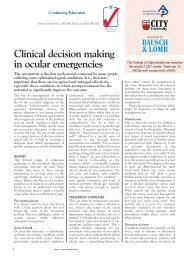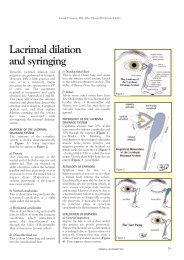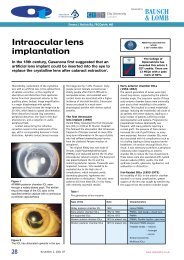You also want an ePaper? Increase the reach of your titles
YUMPU automatically turns print PDFs into web optimized ePapers that Google loves.
CONTINUING EDUCATION AND TRAINING<br />
Gain 2 CET credits - enter online at www.otcet.co.uk or by post<br />
ghosting. Grossly abnormal topography<br />
would not be expected after refractive surgery,<br />
but some patients remain intolerant of<br />
corneal lenses, in which cases ScCLs<br />
could be tried.<br />
Normal topography with high<br />
refractive errors<br />
ScCLs may be indicated when high power<br />
rigid corneal lenses cause intractable problems<br />
of excessive mobility or poor centration.<br />
They may be used whatever <strong>the</strong><br />
ametropia if <strong>the</strong>re is intolerance to corneal<br />
or hydrogel lens wear in high myopia, or<br />
hypermetropia or significant non-pathological<br />
corneal astigmatism.<br />
Therapeutic or protective<br />
applications<br />
ScCLs uniquely retain a pre-corneal fluid<br />
reservoir providing corneal hydration in serious<br />
dry eye conditions, such as Stevens<br />
Johnson Syndrome or ocular cicatricising<br />
pemphigoid. A ScCL in situ may give an<br />
improved environment for corneal healing<br />
where newly formed epi<strong>the</strong>lium is continually<br />
sloughed away by <strong>the</strong> action of <strong>the</strong> lids,<br />
or may prevent tear film evaporation with<br />
poor lid closure or lid absence. The lens<br />
retains a fluid reservoir which maintains<br />
some degree of corneal hydration and<br />
protects <strong>the</strong> cornea from trichiasis and lid<br />
margin keratinisation, and <strong>the</strong> front surface<br />
provides hugely improved refracting surface,<br />
giving a considerable visual benefit.<br />
There is also an application in less severe<br />
dry eye or tears dysfunction pathology.<br />
Sometimes <strong>the</strong> patient may describe very distressing<br />
and disproportionate ocular discomfort<br />
with very little visible corneal disruption.<br />
Mucus filaments adherent to <strong>the</strong> cornea are<br />
very painful when <strong>the</strong>y pull on <strong>the</strong> epi<strong>the</strong>lium<br />
or finally detach, but wave freely in <strong>the</strong> precorneal<br />
fluid reservoir behind a ScCL, and<br />
appear to float off into <strong>the</strong> fluid pool with little<br />
discomfort. ScCLs may be used as a prop<br />
for some cases of ptosis.<br />
Cosmetic shells<br />
A realistic iris can be encapsulated into<br />
PMMA scleral shells to mask unsightly blind<br />
eyes, or to relieve intractable diplopia or<br />
glare in cases of aniridia.<br />
Recreational or occupational<br />
applications<br />
Particles behind rigid corneal lenses in dusty<br />
work place environments are very troublesome.<br />
ScCLs eliminate this problem almost<br />
entirely. Most recreational activities are satisfactorily<br />
managed with <strong>the</strong> use of hydrogel<br />
lenses, but ScCLs are still indicated on<br />
occasions for contact or water sports.<br />
ScCL fitting options<br />
Ventilation by some means is a prerequisite<br />
for PMMA lenses whe<strong>the</strong>r impression or preformed,<br />
but non-ventilated designs are <strong>the</strong><br />
preferred option for RGP. Some limitations<br />
still remain for irregular ocular topography<br />
with RGP preformed sclerals, but considerably<br />
more irregular eyes can be fitted using<br />
preformed RGP sclerals because of <strong>the</strong> tear<br />
reservoir compared to fenestrated PMMA.<br />
Impression lenses of some kind can be used<br />
virtually irrespective of irregular topography.<br />
All <strong>the</strong> following alternatives are possible,<br />
and have different applications.<br />
RGP<br />
RGP sclerals should now be considered <strong>the</strong><br />
first choice for <strong>the</strong> great majority of ScCL<br />
cases. Some long-term wearers have worn<br />
<strong>the</strong> lenses for over 50 years, so <strong>the</strong>se should<br />
be considered a long-term option for most<br />
new referrals. As <strong>the</strong> great majority of ScCL<br />
referrals are for PCE or corneal transplant, it is<br />
crucial to minimise <strong>the</strong> risk of corneal hypoxia.<br />
A transplant may have to be a future management<br />
option for any PCE referred for ScCL<br />
fitting. If so, corneal neovascularisation, while<br />
not necessarily sight-threatening in its own<br />
right in <strong>the</strong> early stages, may increase <strong>the</strong> risk<br />
of transplant rejection.<br />
Preformed non-ventilated RGP can be<br />
used for <strong>the</strong> great majority of cases, irrespective<br />
of corneal topography. There are more<br />
potential problems with <strong>the</strong> scleral topography,<br />
but if <strong>the</strong> scleral zone is well enough<br />
sealed, a pre-corneal fluid reservoir is<br />
retained without bubbles and with minimal<br />
settling on <strong>the</strong> globe. The optimum clearance<br />
at <strong>the</strong> visual axis is approximately 0.25mm,<br />
but can be more than twice that value at <strong>the</strong><br />
limbus in some sectors without causing any<br />
problems provided it remains air free.<br />
The principal problem with preformed<br />
non-ventilated RGP ScCLs is that <strong>the</strong>y have<br />
to be inserted filled with saline. This requires<br />
keeping <strong>the</strong> lens horizontal at <strong>the</strong> moment<br />
of insertion, so it is necessary also to have<br />
<strong>the</strong> patient’s head horizontal and facing <strong>the</strong><br />
floor. This is a more difficult task for<br />
patients, and sometimes for <strong>the</strong> practitioner<br />
as well, compared to <strong>the</strong> relatively simple<br />
procedure for inserting a fenestrated lens,<br />
which can be inserted with <strong>the</strong> head in <strong>the</strong><br />
normal upright posture.<br />
Preformed fenestrated RGP is indicated<br />
if a fenestration is beneficial, for<br />
example, if retention of <strong>the</strong> pre-corneal fluid<br />
reservoir at <strong>the</strong> moment of insertion is<br />
impossible. However, <strong>the</strong>re is a serious limitation<br />
because air bubbles are admitted into<br />
<strong>the</strong> pre-corneal fluid reservoir and cross <strong>the</strong><br />
visual axis if <strong>the</strong> pre-corneal fluid reservoir<br />
depth is greater than 0.1mm. It is unlikely<br />
that a tear pool of uniformly shallow depth<br />
can be maintained with even just a moderately<br />
irregular corneal topography.<br />
Impression non-ventilated RGP is an<br />
option if <strong>the</strong>re is an intractable problem<br />
retaining an air free pre-corneal fluid reservoir<br />
with a non-ventilated preformed<br />
design. The ultimate fitting target is a flush<br />
back surface for <strong>the</strong> scleral zone and an<br />
optic zone clearance similar to that for a<br />
non-ventilated preformed RGP. As <strong>the</strong> scleral<br />
zone is fabricated from an eye impression,<br />
a very good alignment can be expected with<br />
effective sealing on <strong>the</strong> scleral zone, hence<br />
<strong>the</strong>re is scope for increasing <strong>the</strong> optic zone<br />
clearance with a good prospect of retaining<br />
a pre-corneal fluid reservoir.<br />
Impression fenestrated RGP is a major<br />
undertaking because it is a departure from<br />
mainstream manufacturing and, in<br />
addition, requires very precise fabrication of<br />
<strong>the</strong> back surface to keep a uniform depth of<br />
<strong>the</strong> pre-corneal fluid reservoir. However,<br />
<strong>the</strong>re may be a better chance than with a<br />
fenestrated preformed RGP lens because<br />
<strong>the</strong> optic zone is individually fabricated from<br />
<strong>the</strong> exact shape of <strong>the</strong> eye.<br />
PMMA<br />
PMMA ScCLs still have a role to play but<br />
<strong>the</strong>re is an acknowledged long-term threat of<br />
hypoxic corneal changes, so <strong>the</strong>se would not<br />
normally be <strong>the</strong> first choice for new ScCL<br />
wearers. However, if a PMMA lens has been<br />
worn successfully for some years without significant<br />
sequelae, <strong>the</strong>re is no reason for a<br />
change is to be made. Most impression<br />
PMMA lenses for moderate or advanced<br />
corneal ectasias were ventilated, hence <strong>the</strong><br />
initial clearance at <strong>the</strong> visual axis could not be<br />
much more than 0.1mm. After a period of<br />
settling on <strong>the</strong> globe, an almost universal<br />
occurrence with a ventilated lens, <strong>the</strong> result<br />
was apical contact. The author’s observation<br />
is that contact is better tolerated in PMMA<br />
than with RGP materials. The probable explanation<br />
is <strong>the</strong> increased co-efficient of friction<br />
28 | October 20 | 2006 | OT
















